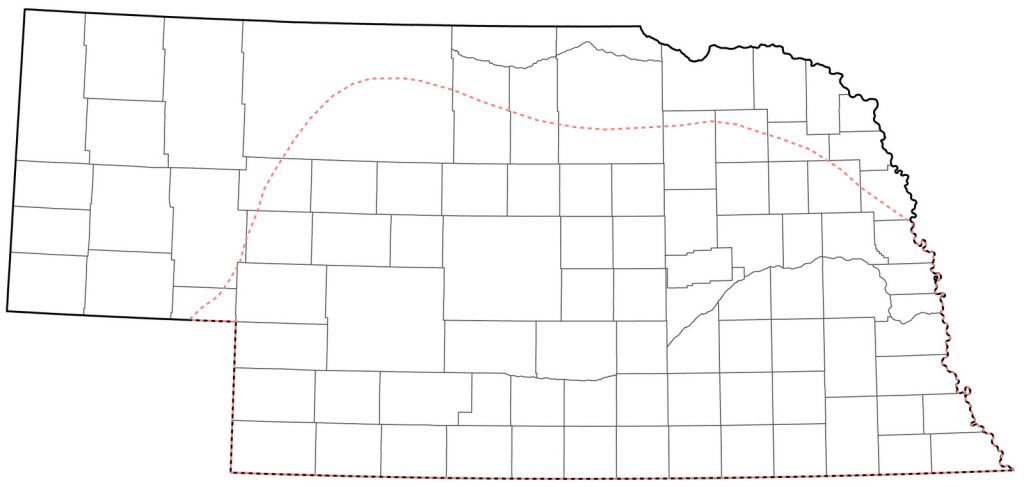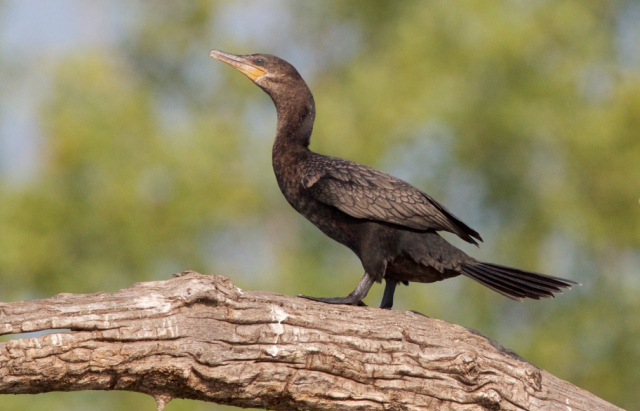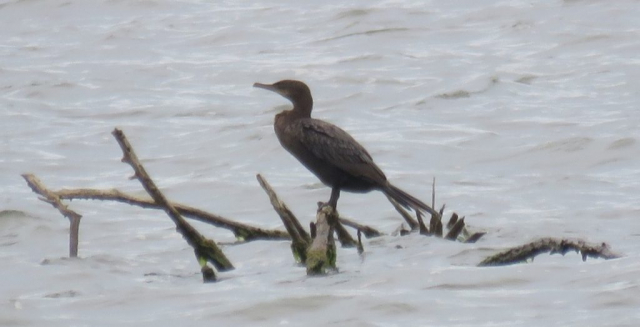Nannopterum brasilianum mexicanum
Status: Increasing. Rare regular statewide summer visitor.

Documentation: Specimen: UNSM ZM14226, 2 Oct 1982 Sutherland Reservoir (Wright 1983).
Taxonomy: Chesser et al (2021) split New World Double-crested, Neotropic, and Flightless cormorants from Phalacrocorax to the resurrected genus Nannopterum, which required a specific epithet change from brasilianus to brasilianum and subspecies change from mexicanus to mexicanum.
Two subspecies have been recognized (AviList 2025), mexicanum in the extreme southern United States, Caribbean, and Nicaragua, and brasilianum from Costa Rica south throughout South America.
Nebraska birds are presumed mexicanum, although Pyle (2025) synonymized the two subspecies based on failure to meet the 75% rule for diagnosability.
A Nebraska hybrid with Double-crested Cormorant is discussed in the Double-crested x Neotropic Cormorant (hybrid) species account.
Summer: Mar 31, Apr 1, 4 <<<>>> Oct 1, 1, 2
Earlier dates are 12 Mar 2020 Pawnee Lake, Lancaster Co, 1-2 on 12 Mar-16 Apr 2012 Branched Oak Lake, Lancaster Co (Brogie 2013), 20 Mar 2020 Wagon Train RA, Lancaster Co, 21 Mar-25 Aug 2017 Branched Oak Lake (Silcock 2017a, 2017b, 2017c) and 29 Mar 2018 at Branched Oak Lake. Additional early sightings without details are of one in flight with Double-crested Cormorants in Buffalo Co 16 Mar 2012, and one at Branched Oak Lake 26 Mar 1998 (Brogie 1999).
A later date is 26 Nov 2010 Branched Oak Lake (Silcock 2010).
An intriguing record was of two adults with an immature at Lake McConaughy, Keith Co 2 Jul 2024, raising the possibility of breeding, although the immature was perhaps more likely to have been a one-year-old rather than a recent fledgling based on egg dates.
Of 36 accepted records, 31 are from 2000-2025, indicative of increasing drift northward in recent years. Breeding first occurred in Kansas in 2007 (Thompson et al 2011), but as of 2024 has not been reported in Nebraska.
Images
Abbreviations
UNSM: University of Nebraska State Museum
Literature Cited
AviList Core Team, 2025. AviList: The Global Avian Checklist, v2025. https://doi.org/10.2173/avilist.v2025.
Brogie, M.A. 1999. 1998 (Tenth) Report of the NOU Records Committee. NBR 67: 141-152.
Brogie, M.A. 2013. 2012 (24th) Report of the NOU Records Committee. NBR: 81: 120-130.
Chesser, R.T., S.M. Billerman, K. Burns, C. Cicero, J.L. Dunn, B.E. Hernández-Baños, A.W. Kratter, I.J. Lovette, N.A. Mason, P.C. Rasmussen, J.V. Remsen, Jr., D.F. Stotz, and K. Winker. 2021. Sixty-second Supplement to the American Ornithological Society’s Check-list of North American Birds. Ornithology 138, Issue 3 https://doi.org/10.1093/ornithology/ukab037.
Silcock, W.R. 2010. Fall Field Report, August-November 2010. NBR 78: 130-150.
Silcock, W.R. 2017a. Spring Field report, March-May 2017. NBR 85: 54-83.
Silcock, W.R. 2017b. Summer Field Report, June-July 2017. NBR 85: 94-120.
Silcock, W.R. 2017c. Fall Field Report, August-November 2017. NBR 85: 146-178.
Thompson, M.C., C.A. Ely, B. Gress, C. Otte, S.T. Patti, D. Seibel, and E.A. Young. 2011. Birds of Kansas. University Press of Kansas, Lawrence, Kansas, USA.
Wright, R. 1983. Olivaceus Cormorant. NBR 51: 18.
Recommended Citation
Silcock, W.R., and J.G. Jorgensen. 2025. Neotropic Cormorant (Nannopterum brasilianum mexicanum). In Birds of Nebraska — Online. www.BirdsofNebraska.org
Birds of Nebraska – Online
Updated 17 Oct 2025


